OPOD - Moon Halo Montage
OPOD - Moon Halo Montage: A Fascinating Display of Atmospheric Optics
Moon halos, a captivating atmospheric optical phenomenon, have recently taken the spotlight in the February lunation. This celestial spectacle has caught the attention of observers worldwide, with an influx of submissions to OPOD showcasing the beauty and mystery of these halos. From European stargazers braving the cold to those in warmer climes, the night skies have been illuminated by the enchanting glow of moon halos.
Moon halos are a familiar yet only partially understood phenomenon that grace our skies. Contrary to popular belief, they are not perfect rings but rather display a unique glow that extends beyond their subdued red inner edge. The halo gradually fades into velvety darkness, creating a mesmerizing visual effect against the backdrop of the night sky.
One intriguing aspect of moon halos is their size, which can be gauged by observing the stars. As seen in images centered on the moon in Taurus, these halos extend their reach through constellations such as Orion the Hunter and Perseus, son of Zeus and Danae, founder of Mycenae. The vast expanse covered by moon halos adds to their allure, captivating observers with their celestial grandeur.
Let's take a closer look at some of the stunning moon halo images captured by talented photographers around the world:
- Roberto Porto's image from warm Tenerife in the Spanish Canary Islands portrays the moon majestically high in the sky, surrounded by the enchanting halo.
- Tamás Ábrahám, from his backyard in Hungary, skillfully captures the constellations alongside the moon halo, offering a celestial tapestry of astronomical beauty.
- Robert Rosenberg's image from Adony, Hungary, showcases the moon halo against a striking landscape, highlighting the ethereal nature of this atmospheric phenomenon.
- Bob Colwell's photograph from New Hampshire, USA, reveals the moon halo in conjunction with the vibrant red hues of supergiant stars Betelgeuse and Aldebaran, creating a breathtaking composition.
- Peter Frankland's Australian halo picture taken in Brisbane adds a touch of diversity to the collection, demonstrating that moon halos can be observed and appreciated across different regions of the globe.
- Tamas Ladanyi's image captures the moon halo elegantly gracing the castle at Veszprem in Hungary, merging natural and architectural beauty in a single frame.
- Brandon Longo's unique photograph showcases a fragment of a lunar circumscribed halo, offering a glimpse into the intricate and ever-changing nature of atmospheric optics.
Moon halos are not the only atmospheric optical phenomena that can be observed during these celestial displays. In addition to the 22-degree halo, observers have reported sightings of circumscribed arcs, circumzenithal arcs, sundogs, and moon dogs. These fleeting phenomena add an extra layer of wonder and complexity to the overall experience.
The formation and duration of moon halos are influenced by various atmospheric conditions. Cirrostratus clouds, for example, can play a role in the appearance and disappearance of these halos. Observers have noted that moon halos may form as early as 3:15 UTC and last until approximately 5:30 UTC, depending on the movement and dissipation of cirrostratus clouds.
Moon halos continue to captivate the imagination of both seasoned observers and newcomers to the world of atmospheric optics. The ever-changing dance between light and atmosphere creates a spectacle that reminds us of the beauty and complexity of our natural world. Whether you are in a cold European night or a warmer climate, keep your eyes on the night sky, for you never know when the next moon halo will grace us with its presence.
Please note that this article has been automatically converted from the old site and may not appear as intended. For the original article, please visit the provided link.
Images used in this article are copyrighted by the individual photographers and are shown with their permission.
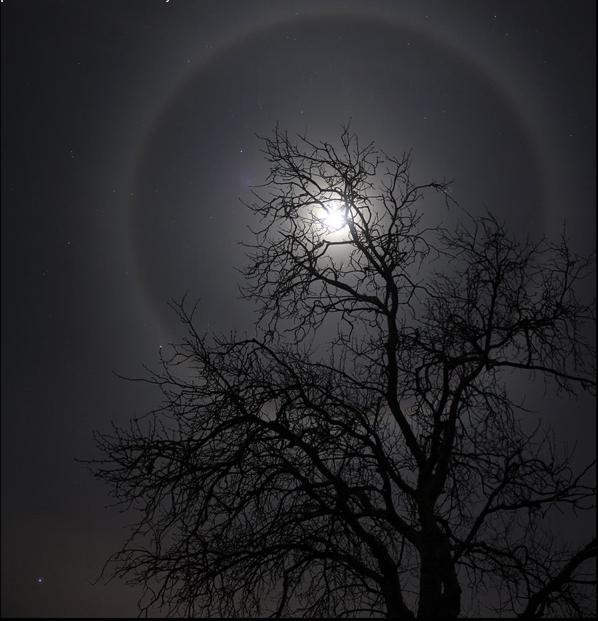
Moon Halos
At right silhouetted against winter's bare branches, a 22° halo imaged by Rafael Schmall in Hungary at Fejer, Adony city. ISO400, 13s exp, f 3.5
This February's lunation saw an unusually large number of 22° halos submitted to OPOD! Here are some. European observers braved brutally cold clear nights. Others were in warmer climes.
Night skies show well this familiar, most frequent yet only partially understood halo.
We see it is not a ring but instead glows outside its subdued red inner edge shading slowly into velvety darkness.
The stars help gauge its size. Here it is centred on the moon in Taurus yet on one side slices through Orion the Hunter and on the other reaches Perseus son of Zeus and Danae, founder of Mycenae.
All images ©individual photographers, shown with permission
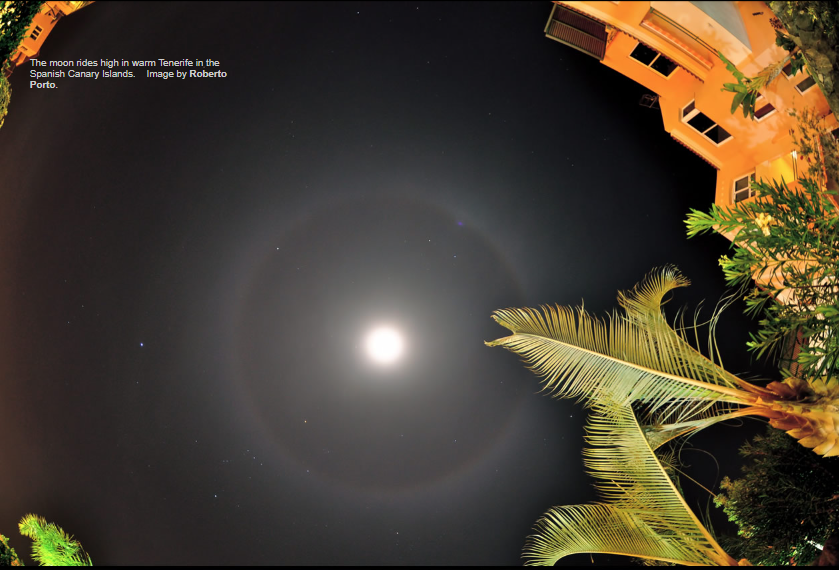
The moon rides high in warm Tenerife in the Spanish Canary Islands. Image by Roberto Porto.
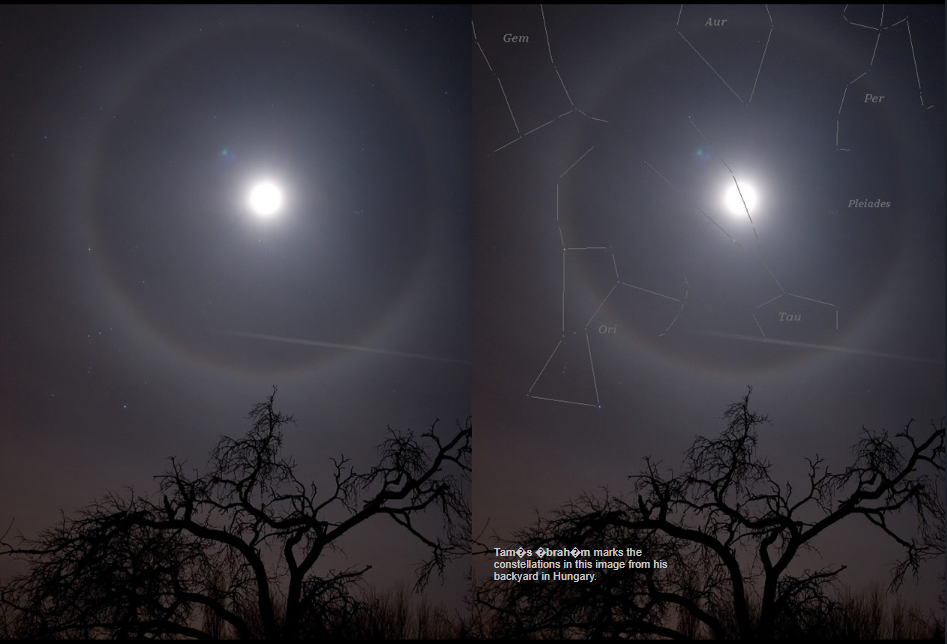
Tam�s �brah�m marks the constellations in this image from his backyard in Hungary.
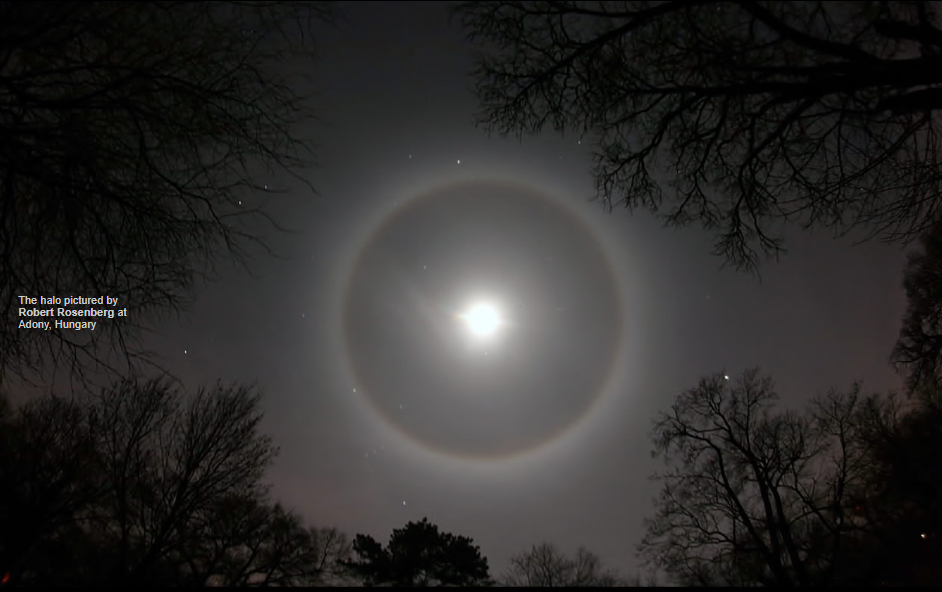
The halo pictured by Robert Rosenberg at Adony, Hungary
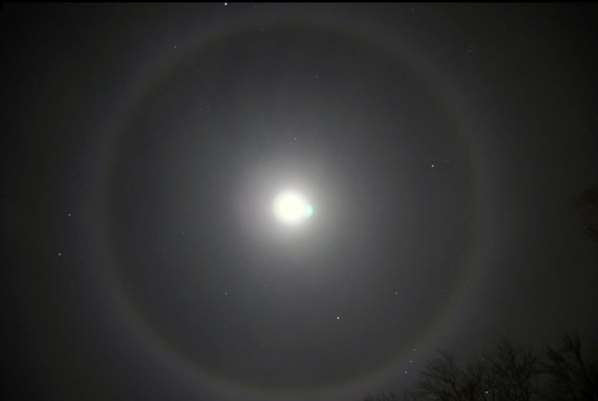
The scene from New Hampshire, USA pictured by Bob Colwell.
Note the red hues of supergiant Betelgeuse and Aldebaran.
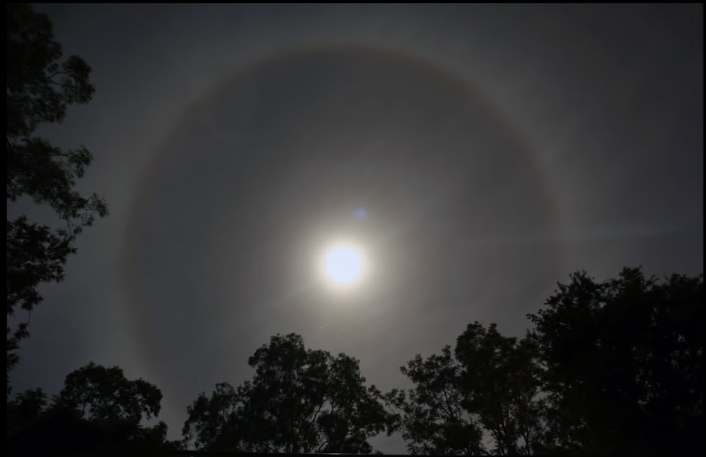
Australian halo pictured at Brisbane by Peter Frankland
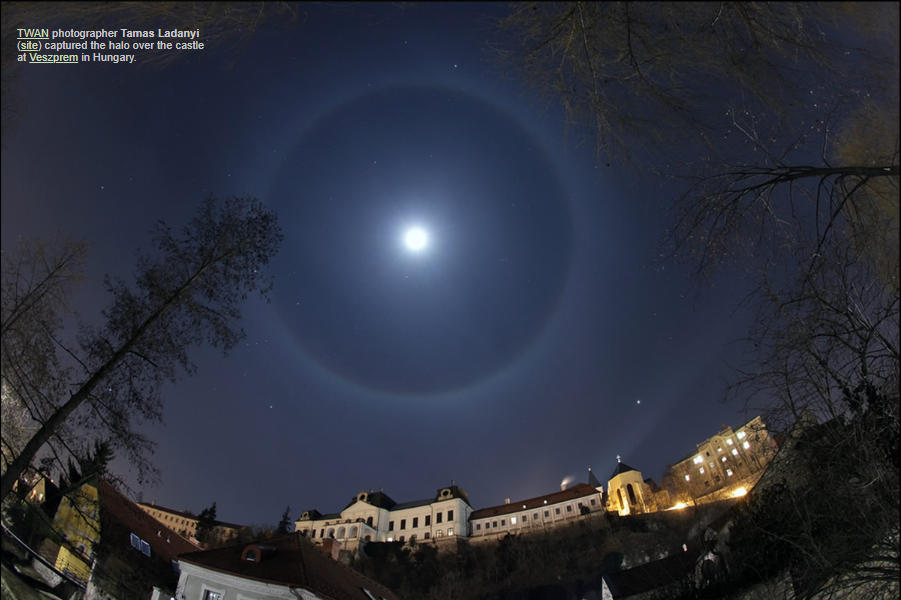
TWAN photographer Tamas Ladanyi (site) captured the halo over the castle at Veszprem in Hungary.
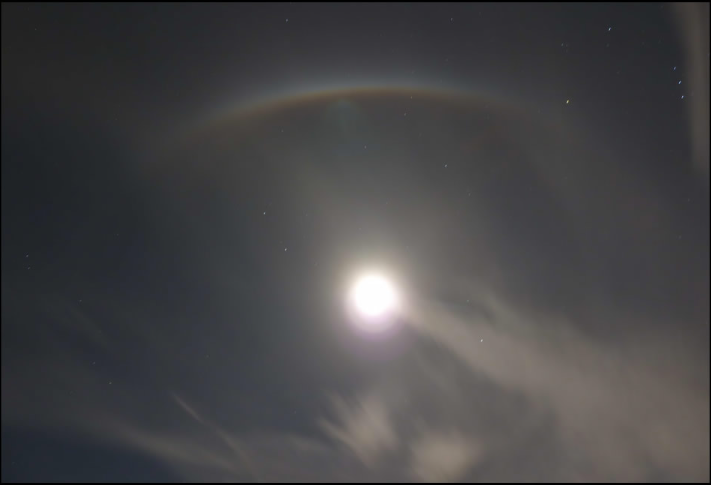
Enough of circles? Brandon Longo saw this fragment of a lunar circumscribed halo at Ventura, California, USA.
"There was a circumscribed arc above, but not around, the sun earlier that day. In addition, there was a circumzenithal arc, a weak 22 degree halo and sundogs. The solar halos lasted no more than 25 minutes since I first saw them. After sunset, when the moon was about 20° high, there weren't any halos visible except for an evanescent moon dog that formed after a contrail remnant passed by.
Then around 3:15 UTC, a lunar 22° formed. This lasted until ~5:30 UTC when the cirrostratus clouds left. At 3:55 UTC I noticed brightening of the top of the 22° halo and the photo that I was taking at the time showed a circumscribed arc forming. Within 10 minutes it was the dominating feature."
Note: this article has been automatically converted from the old site and may not appear as intended. You can find the original article here.
Reference Atmospheric Optics
If you use any of the definitions, information, or data presented on Atmospheric Optics, please copy the link or reference below to properly credit us as the reference source. Thank you!
-
<a href="https://atoptics.co.uk/blog/opod-moon-halo-montage/">OPOD - Moon Halo Montage</a>
-
"OPOD - Moon Halo Montage". Atmospheric Optics. Accessed on November 26, 2024. https://atoptics.co.uk/blog/opod-moon-halo-montage/.
-
"OPOD - Moon Halo Montage". Atmospheric Optics, https://atoptics.co.uk/blog/opod-moon-halo-montage/. Accessed 26 November, 2024
-
OPOD - Moon Halo Montage. Atmospheric Optics. Retrieved from https://atoptics.co.uk/blog/opod-moon-halo-montage/.